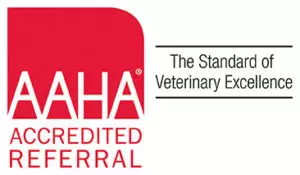When to Call an Emergency Veterinarian

In this article, we will show you six of the most common situations in which you might need an emergency veterinarian. Read through this list to understand what may be considered a pet emergency. And if you ever need emergency pet care, call Long Island Veterinary Specialists at (516) 501-1700.
If your pet is not breathing
If your pet is having difficulty breathing or has stopped breathing suddenly altogether, it is time to call the emergency veterinarian right away. Do not wait, but also keep a close eye on your pet while you call the veterinarian. If you know how to perform CPR on your pet, you may want to try this as well, depending on the circumstances.
You may also need to go to the emergency vet if your pet is breathing; but is struggling to do so. The quicker you respond in a severe emergency situation like this, the better your pet’s chances of recovery will be.
If your pet is having a severe allergic reaction
Many times, pets are stung or bitten by insects and they do not have much of an allergic reaction at all. Some pets may simply get a little itchy or have a small amount of swelling at the location of the bite, and this is nothing to worry about.
However, some pets will have a severe allergic reaction, and this is usually a reason to call an emergency veterinarian. These reactions can include an increased heart rate, a fever, or—most commonly—swelling of the face and snout. Severe reactions can affect your pet’s breathing, so it’s very important to be vigilant if you suspect a reaction. Watch your pet closely after an insect or snake bite for signs of other allergic reactions.
If your pet has been injured
If your pet receives an acute injury—which means an injury that happens suddenly and is not related to an ongoing problem—then you may need to consider going to the emergency veterinarian, depending on the severity of the trauma. For example, if your pet is struck by a car or is attacked by another animal, it is important to call the emergency veterinarian as soon as possible.
Some injuries can wait until your primary veterinarian’s office is available, especially if they are not severe. When in doubt, it is always a good idea to reach out to an emergency veterinarian and ask them for advice.
If your pet is vomiting uncontrollably
Vomiting uncontrollably is a sign that something is very wrong with your pet, and it can also lead to dehydration in a very short amount of time. For these reasons, it is important to get your pet to the emergency veterinarian right away if she is vomiting and can’t stop—or if diarrhea is accompanying this problem.
Dehydration is very dangerous for animals, and many animals can die from dehydration in just a couple of days. The emergency veterinarian will give your pet IV fluids and help diagnose what could be causing her to vomit so much.
If your pet has suffered a seizure for the first time
Pets who have suffered a seizure for the first time and do not have a prior history of seizures will need to go to the emergency veterinarian if their primary veterinarian is not available at the time. If your pet has known seizures, however, you do not need to rush to the emergency veterinarian every time this occurs.
You should, however, go to the emergency veterinarian if your pet has a seizure that lasts longer than about two minutes. You should also consider the situation an emergency if your pet is having multiple seizures within the span of a few hours.
If your pet has heatstroke
Finally, if your pet has heatstroke or is showing any of the symptoms of heatstroke, you should go to the emergency veterinarian immediately. Heatstroke can occur even when you do not think it is necessarily hot enough outside, and it can happen in just a few minutes if a pet is left locked in a hot car.
Heatstroke symptoms include heavy panting, drooling, difficulty breathing, and a very high, rapid heart rate. Pets may eventually become lethargic or unable to rouse if the condition persists. Quick response is crucial in saving a pet who is suffering from heatstroke.
Remember to never leave your pet unattended outside on hot days, or unattended in a vehicle – even if it is not hot outside. Always ensure that your pet has access to clean water and cool areas in and around your home.
These are just some of the situations in which you might need to contact an emergency veterinarian in Plainview. You know your pet better than anyone else, so only you can tell for sure whether or not your pet is experiencing an emergency. These guidelines can help make the decision easier if the unfortunate circumstance ever presents itself.
For more examples of pet emergency situations, visit our Emergency & Critical Care service page. If you believe your pet is experiencing an emergency, contact your primary veterinarian immediately. In the event of an after-hours emergency or if your primary veterinarian is unavailable, contact LIVS: (516) 501-1700.



